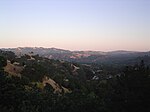Acalanes High School
Acalanes High School is a public secondary school located in Lafayette, California, United States, in the San Francisco Bay Area, within Contra Costa County. Acalanes was the first of four high schools established in the Acalanes Union High School District. It was built in 1940 on what was then a tomato field, using federal government funds with labor provided by the Works Project Administration, the largest and most ambitious New Deal agency introduced by the Roosevelt administration. Lafayette businessman M.H. Stanley suggested the name "Acalanes", the name of Rancho Acalanes, the Mexican grant from which all land title within the City of Lafayette derives. Rancho Acalanes itself seems to have been named by its Hispanic settlers after the local Native American Bay Miwok tribe called Saklan (Saclan), referred to by Spanish missionaries as Saclanes. The first graduating class of 1941 selected the school colors of blue and white. For the school sports mascot, they chose the Don (a Spanish honorary title).
Excerpt from the Wikipedia article Acalanes High School (License: CC BY-SA 3.0, Authors).Acalanes High School
Pleasant Hill Road,
Geographical coordinates (GPS) Address External links Nearby Places Show on map
Geographical coordinates (GPS)
| Latitude | Longitude |
|---|---|
| N 37.90481 ° | E -122.09842 ° |
Address
Acalanes High School
Pleasant Hill Road 1200
94549
California, United States
Open on Google Maps



